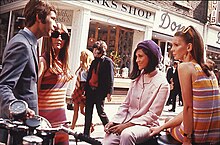Foubert's Place

Swinging London, Carnaby Street, c. 1966.
|
|
| Maintained by | Westminster City Council |
|---|---|
| Location | Soho, London |
| Postal code | W1 |
| Nearest Tube station |
|
| Coordinates | 51°30′48″N 0°08′20″W / 51.51333°N 0.13889°WCoordinates: 51°30′48″N 0°08′20″W / 51.51333°N 0.13889°W |
| South end | Beak Street |
| North end | Great Marlborough Street |
| Construction | |
| Inauguration | 1685 or 1686 |
| Other | |
| Known for | 1960s fashion |
| Status | Pedestrianised |
Carnaby Street is a pedestrianised shopping street in Soho in the City of Westminster, Central London. Close to Oxford Street and Regent Street, it is home to fashion and lifestyle retailers, including a large number of independent fashion boutiques.
Streets crossing, or meeting with, Carnaby Street are, from south to north, Beak Street, Broadwick Street, Kingly Court, Ganton Street, Marlborough Court, Lowndes Court, Fouberts Place, Little Marlborough Street and Great Marlborough Street. The nearest London Underground station is Oxford Circus (on the Bakerloo, Central and Victoria lines).
Carnaby Street derives its name from Karnaby House, which was built in 1683 to the east. The origin of the name is unknown. The street was probably laid out in 1685 or 1686. First appearing in the ratebooks in 1687, it was almost completely built up by 1690 with small houses. A market was developed in the 1820s. In his novel, Sybil (1845), Benjamin Disraeli refers to "a carcase-butcher famous in Carnaby-market".
This area is notable for a cholera outbreak in 1854 leading to an early application of fundamental epidemiological principles to resolve the crisis. John Snow, the physician who recognised the cases were concentrated near a pump on Broad Street communicated the finding on a map-based graphic. It led to the pump being locked and the reduction in cases of cholera was rapid.
...
Wikipedia
